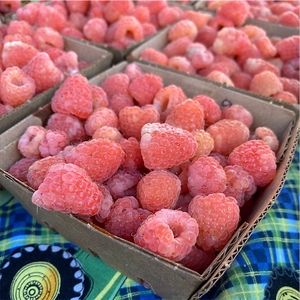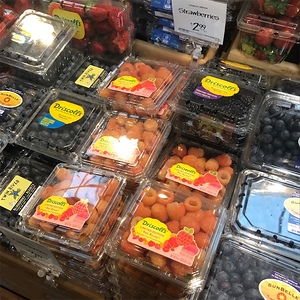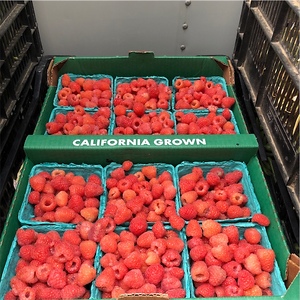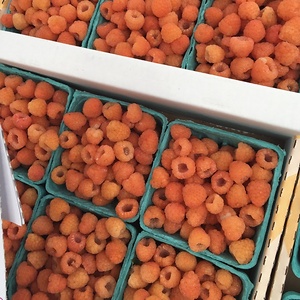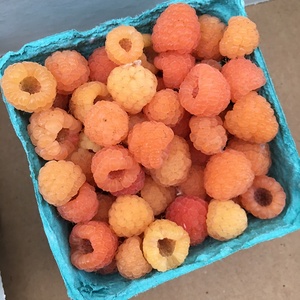


Sunshine Raspberries
Estimated Inventory, 12 ct : 0
Description/Taste
Sunshine raspberries are a hybrid variety with a unique orange hue. They are similar in size and shape to Red raspberries, featuring a loosely conical structure made up of small drupelets. Each individual raspberry contains small seeds and short, red hairs that peek out between the drupelets. Sunshine raspberries are a marbled mixture of both orange and yellow, with an overall golden-orange tone and patches of lighter yellow throughout their body. Their skin is firm yet soft, with a shiny texture on the outside. When squeezed, these raspberries emit juice. The inside of the fruit is hollow enough to fit a small fingertip. A faint white residue coats the drupelets, giving them a more matte appearance compared to the shiny outside of the raspberries. This variety has a sweet, honeyed taste with notes of peach and apricot and is far less tart than Red raspberries.
Seasons/Availability
Sunshine raspberries are available from late fall to early winter.
Current Facts
Sunshine raspberries are botanically classified as Rubus idaeus and belong to the Rosaceae family, which encompasses over 2,500 species, including apricots, cherries, nectarines, plums, and apples. Sunshine raspberries are considered a bramble fruit, along with all other raspberries, as well as blackberries, marionberries, loganberries, and boysenberries. They are a hybrid variety resulting from a cross between Golden and Red raspberries. Golden raspberries are native to the Himalayan mountains and are the result of a natural mutation that prevents the fruit from producing darker pigments called anthocyanins. They have a true yellow-gold hue, in contrast to the orange-tinted color of the Sunshine variety. Other Golden raspberry variations may have hues ranging from pale yellow to pink. Sunshine raspberries are prized for their culinary versatility and ornamental appeal, thanks to their vibrant orange hue.
Nutritional Value
The nutritional value of Sunshine raspberries isn’t widely known, but raspberry species in general are a significant source of vitamin C, a powerful antioxidant that supports the immune system, promotes healthy skin, and aids in wound healing. Manganese, another key nutrient in raspberries, plays an important role in bone health, metabolism, and the formation of connective tissues. Raspberries are rich in fiber, which aids digestion, promotes a feeling of fullness, and helps regulate blood sugar levels, making them beneficial for weight management and heart health. The anthocyanins found in Red raspberries give them their vibrant color, so hybrid yellow varieties like Sunshine raspberries may contain less of this nutrient but can still harness some of these antioxidants' abilities to reduce inflammation, support brain health, and protect against cardiovascular issues. Sunshine raspberries contain polyphenolic compounds that may benefit brain and gut health, improve cholesterol and blood pressure levels, enhance vascular function, protect against UV rays, and reduce oxidative stress.
Applications
Use Sunshine raspberries as you would golden raspberries, as they have the same super sweet flavor without pigmentation. They are primarily used in desserts and preserves but can also be suitable in savory applications like salads, meat sauces, grain bowls, and salsas. Sunshine raspberries make a colorful contribution to glazed tarts, cheesecakes, pies, bars, sorbets, cakes, and waffles. Complementary pairings include cocoa, exotic fruits, raisins, nuts such as hazelnuts and Marcona almonds, apricots, honey, peaches, coconut, cinnamon, blueberries, cardamom, and lavender. Like other berries, Sunshine raspberries are very perishable and should be consumed within a few days.
Ethnic/Cultural Info
The raspberry species is believed to have received its botanical name, Rubus idaeus, from a quest by the Olympic gods to find berries on Mount Ida. Rubus idaeus also translates to bramble bush of Ida, as raspberries are a type of bramble berry. Ida is further referenced in the story of Ida from the Hellenistic Troy Era. Ida was a nursemaid to Zeus when he was an infant. While caring for the child, she pricked her finger picking white berries, staining them forever in the hue of Red raspberries.
Geography/History
Sunshine raspberries were initially developed in the early 2010s at Cornell University and were originally sold and trademarked by Driscoll’s produce company in 2009. This variety is grown in temperate climates that experience full sun exposure and range between 13 to 21 degrees Celsius during their growing season. Sunshine raspberries are a naturally bred hybrid that can be sown in home gardens or produced commercially. This variety descends from raspberry species native to the Fertile Crescent regions of Eastern Europe, particularly modern-day Turkey. Raspberries also have origins in North America, where they were first commercially sold in the early 1700s, and many new hybrids were developed over the following two centuries. Sunshine raspberries are a niche variety that may be found in specialty stores and farmers' markets, particularly in regions like the Central Valley of California, which has a favorable climate for berry cultivation.
Recipe Ideas
Recipes that include Sunshine Raspberries. One



